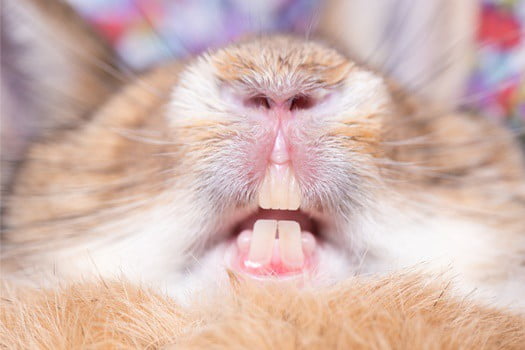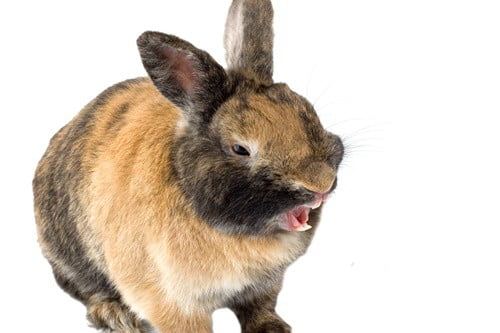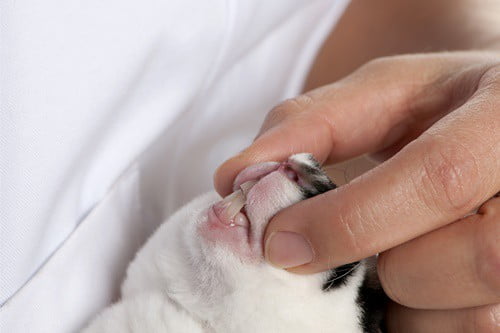A rabbit’s teeth never stop growing throughout their life. This means they must be trimmed and filed down regularly. Failing to do so will lead to the teeth becoming overgrown. This will be painful for your rabbit, and detrimental to its long-term health.
Wild rabbits chew on tree branches and twigs to wear down the teeth. For a pet rabbit, this can be achieved by filling its hutch with hay, safe/solid wood blocks, and chew toys.
If chewing alone does not keep your rabbit’s teeth trim, you can trim a rabbit’s teeth with wire cutters. Alternatively, a vet can shorten a rabbit’s teeth via a process known as burring.
Why Do Rabbits Have Long Teeth?
A rabbit’s teeth continue to grow due to the diet of rabbits. A wild rabbit needs to graze to survive. In an ideal world, these rabbits would eat grass constantly. That is not always an option, though. Wild rabbits sometimes need to eat tougher food, like rough-growing weeds, branches, and twigs.
This takes a toll on a rabbit’s teeth, wearing them down over time. As rabbit teeth never stop growing, this is not an issue. A rabbit chews to file her teeth and they grow back as good as new. But it can become a problem for domesticated pets that aren’t fed enough Timothy hay.
How Many Teeth Do Rabbits Have?
A healthy rabbit should have 28 teeth in her mouth. Only four of these teeth are easily visible to the human eye. Rabbits have the following teeth:
- Two upper incisors at the front of her mouth. These are prominent buck teeth.
- Two lower incisors at the bottom of her mouth. These teeth should never clash with the upper incisors. Overlapping is key. The upper incisors slot neatly in front of the lower.
- Two tiny incisors behind the upper front teeth. These are sometimes referred to as peg teeth.
- Twelve molars in the back of the rabbit’s upper mouth. These are hidden within the gums.
- Ten more molars in the back of the rabbit’s lower mouth. These are invisible to the human eye.
All of these teeth is important to a rabbit. They are used to grind food down in their mouths.
How Long Should Rabbit Teeth Be?
| Incisors | The upper and lower incisors should be long, straight, and white. The top incisors should gently overlap the bottom. Your rabbit must be able to close her mouth. |
| Peg Teeth | You should never be able to see your rabbit’s peg teeth. They need to remain safely tucked behind the upper incisors. If these teeth are visible, something is wrong with the incisors. |
| Molars | The molars should follow the same rule as incisors. They have blunt ends, and must not prevent the rabbit from closing her mouth. Your rabbit grinds her molars down chewing just as much as her incisors. |
Regularly inspect your pet’s teeth. Keep an eye out for any signs of misalignment, discoloration or excessive growth. Dental pain is one of the most common health complaints in rabbits.
How to Stop Rabbit’s Teeth from Growing
Pet rabbits need to replicate the lifestyle of wild rabbits. This means they need to be chewing for most of the day, grinding down those long teeth.
The easiest/safest way to encourage chewing is through timothy hay. This form of hay is pure fiber, and tough. This means that your rabbit can eat as much as she likes without any health issues.
Fill your rabbit’s hutch with fresh timothy hay each morning. You will notice that she happily chews on this throughout the day. Rabbits particularly love to eat while they poop.
It’s important that you understand the difference between timothy hay and other types, though. Alfalfa hay, for example, must be avoided in adult rabbits.
Alfalfa hay is high in protein and calcium, and low in fiber. That’s fine for growing baby rabbits that need to build their strength. Once your rabbit reaches adulthood, alfalfa hay does more harm than good. It’s too soft to file your pet’s teeth, and it will damage her body.
You will likely notice that your rabbit is compelled to chew other items, too. You need to discourage dangerous chewing, such as electrical cables or hutch wiring.
Not only will this keep your rabbit’s teeth trim, but it will also entertain her. This can be critical if you keep a single rabbit. Rabbits grow bored easily, and boredom leads to stress.

What Can Rabbits Chew on for Their Teeth?
Fill your pet’s hutch with more hay than she’ll eat in a day. Also, you can provide more for your pet to chew on. Consider the following:
- Tree branches and twigs. Apple, pine, aspen, or willow trees are best.
- Plastic baby toys. Your rabbit will have a good time sinking her teeth into toys designed for teething babies.
- Chunks of pinewood – either for burning in a fire, or for construction. Cut these down to size, and attach them to your pet’s hutch.
- Pine cones. Wash them first with water and vinegar.
- Soft cotton towels and face cloths.
- Wicker baskets. Fill these with hay for additional fun. Your rabbit can burrow while she chews.
- Tough plastic toys designed for other animals, such as Kong chews.
- Firm, tough rubber balls. Your rabbit will also play with a ball.
Avoid cheap, basic dog, or cat chew toys. These tend to be made of flimsy plastic. Your rabbit will chew right through them, creating a choking hazard.
Rabbits can chew on cardboard, but tread carefully with this. Your pet will likely eat the cardboard while she chews. That’s fine in small amounts. Too much can cause an intestinal blockage.
Switch up your rabbit’s chewing options every day. If she is faced with the same chew toys all the time, they’ll bore her and she’ll cease chewing. This means her teeth risk becoming overgrown.
How Fast Do Rabbit Teeth Grow?
A rabbit’s teeth grow roughly 2mm every week. Rabbit teeth grow inward, too. The root will move inside the gums of a rabbit. It will eventually reach the nose or eyes if not ground down.
If your rabbit is getting enough fiber, you have nothing to worry about. Hay will grind these teeth down as fast as they grow. A poor diet will lead to a range of health problems, including bad teeth.
How Can I Tell if My Rabbit’s Teeth are Too Long?
There are three main visual tells that a rabbit’s teeth are growing too long:
- Sharpness. Rabbit teeth should be long and blunt. If they start to resemble fangs, urgent clipping is required.
- Discoloration. Healthy rabbit teeth are pure white. If your pet’s teeth are yellowing, they are getting too long.
- Eye or Nasal Discharge. The roots of rabbit teeth can grow inward. If left untrimmed, they may end up irritating the eyes or nose. This leads to a runny nose or excessive tear production.
Regular inspections of your rabbit’s teeth are important. If you look at least once a week, you will discover whether intervention is needed. If this is the case, act before the problem intensifies.
What Happens When a Rabbit’s Teeth Are Overgrown
Dangers are connected to overgrown teeth in rabbits, which are as follows:
- Your rabbit will be unable to close her mouth properly. As rabbits are obligate nasal breathers, this is a serious problem.
- The teeth will potentially cut your pet’s tongue and gums. This can be painful, cause bleeding, and invite bacterial infections.
- It will be too painful for your rabbit to eat. Your pet cannot last much longer than 24 hours without food.
- The teeth will become increasingly brittle, leading to a likelihood of them breaking.
- Your rabbit will be unable to groom herself. This will lead to stress and poor hygiene. Serious health concerns, including flystrike, may follow.
The biggest issue with overgrown teeth is lack of overlapping between the top and bottom incisors. This is known as malocclusion.
Malocclusion can be life-threatening if not treated. The teeth will keep growing, and they will grow misshapen. This means they risk penetrating your pet’s skin. Rabbits are supposed to have blunt teeth, not sharp fangs.
Can You File a Rabbit’s Teeth?
Rabbit’s teeth can be cut down to size manually. Your pet should wear her teeth down through chewing. Sometimes, intervention is the only option. You have two options:
- Take your pet to a professional. A vet will trim your rabbit’s teeth with a small, handheld electric saw. This is known as burring. It grinds the teeth down, rather than cutting them outright.
- Clipping your rabbit’s teeth yourself. This is done by slowly cutting away at your pet’s teeth with wire cutters. This is a risky procedure, so only attempt it if you’re confident.
If you do need a vet, ensure they are skilled in rabbit husbandry. Rabbit’s teeth are different from those of dogs or cats. The Rabbit House Society lists appropriate vets by state.
How Much Does Burring Cost?
This depends on your vet, but expect to pay an average of $75-100 per visit.
If you have a pet insurance policy for your rabbit, see if this covers the cost. It’s unlikely, as most plans do not include dental work. Check if you can purchase this as an optional extra.
Burring is performed on an outpatient basis, under anesthetic. Ensure that you understand fully what this entails. Your rabbit may not be able to eat before the treatment, for example.
You will need to make repeat visits for burring every two months. The only way to avoid this is by trimming the teeth yourself, or your rabbit increasing the amount of chewing.

Can I Trim My Rabbit’s Teeth Myself?
DIY rabbit teeth trimming is possible. This will be stressful for your pet though, and not as effective as burring. Only attempt this if you have a steady hand. It’s trickier than trimming claws.
Rabbits do not like having their teeth or mouths touched. A rabbit’s teeth are their primary form of defense against predators. Rabbits may be small, but they can bite hard.
If you’re poking around in her mouth, expect your rabbit to retaliate. You should build trust before attempting to manual tooth clipping. Get your rabbit used to you handling her mouth and teeth.
Some people may recommend rolling your rabbit onto her back. This is known as ‘trancing,’ and it leaves rabbits completely paralyzed, as though hypnotized. It looks like your rabbit is playing dead.
While this will keep her still, it will also deeply traumatize her. Avoid trancing your rabbit when tooth-clipping. Both these events alone are frightening and traumatic for rabbits.
Once you’re ready to clip your rabbit’s teeth, follow these steps.
- Pet and groom your rabbit to get her completely relaxed. If she reacts to particular scents, use these. Do whatever it takes to get your rabbit into a docile state.
- Wrap your rabbit in a towel to restrain her. Your pet will not like this, but she must remain still.
- Open your rabbit’s mouth. Ensure that her tongue is safely out of your way.
- Take a pair of wire cutters, and clip a small amount of tooth from the upper incisor. It’s easy to cut too far. This could expose the root and leave your rabbit in pain.
- Repeat the above process on the second upper incisor, until both teeth are even.
- Move onto the lower incisors. Again, clip slowly and steadily.
Don’t be surprised if your rabbit will not allow you to clip her teeth. If this is the case, you must find a vet and arrange burring. Rabbits can hold grudges, so she may never trust you again.
Do Rabbits Regrow Lost Teeth?
Rabbits can lose teeth throughout their lifetime. Sometimes a tooth is accidentally pulled or knocked out while chewing or playing. Sometimes a vet, in the event of disease, removes a tooth. Genetic issues can also lead to weak teeth.
As long as the root is not permanently damaged, the tooth will grow back. Your rabbit should not experience any ill effects. She’ll likely eat, play, and exercise as normal.
Keep a close eye on your rabbit’s new tooth, though. Ensure that it does not grow back crooked. In addition, remember that this tooth will grow at a different rate to others. It needs to be filed down.
Do Baby Rabbits Shed Their Teeth?
Rabbits have one set of teeth for life. Baby rabbits do not lose milk teeth and regrow adult teeth. Teeth falling out are not a natural part of rabbit evolution.
She may have moved onto tough, solid food too quickly. She may be clumsy, and prone to head collisions. She may have inherited oral problems from one of her parents. Malocclusion is often described as a genetic condition.


Fantastic article. Thank you for all these great tips. I’ve recently inherited my mother in laws rabbit, and this info will help me to give her a good life.
My rabbit peg tooth is overgrown can I trim them with a nail filer?